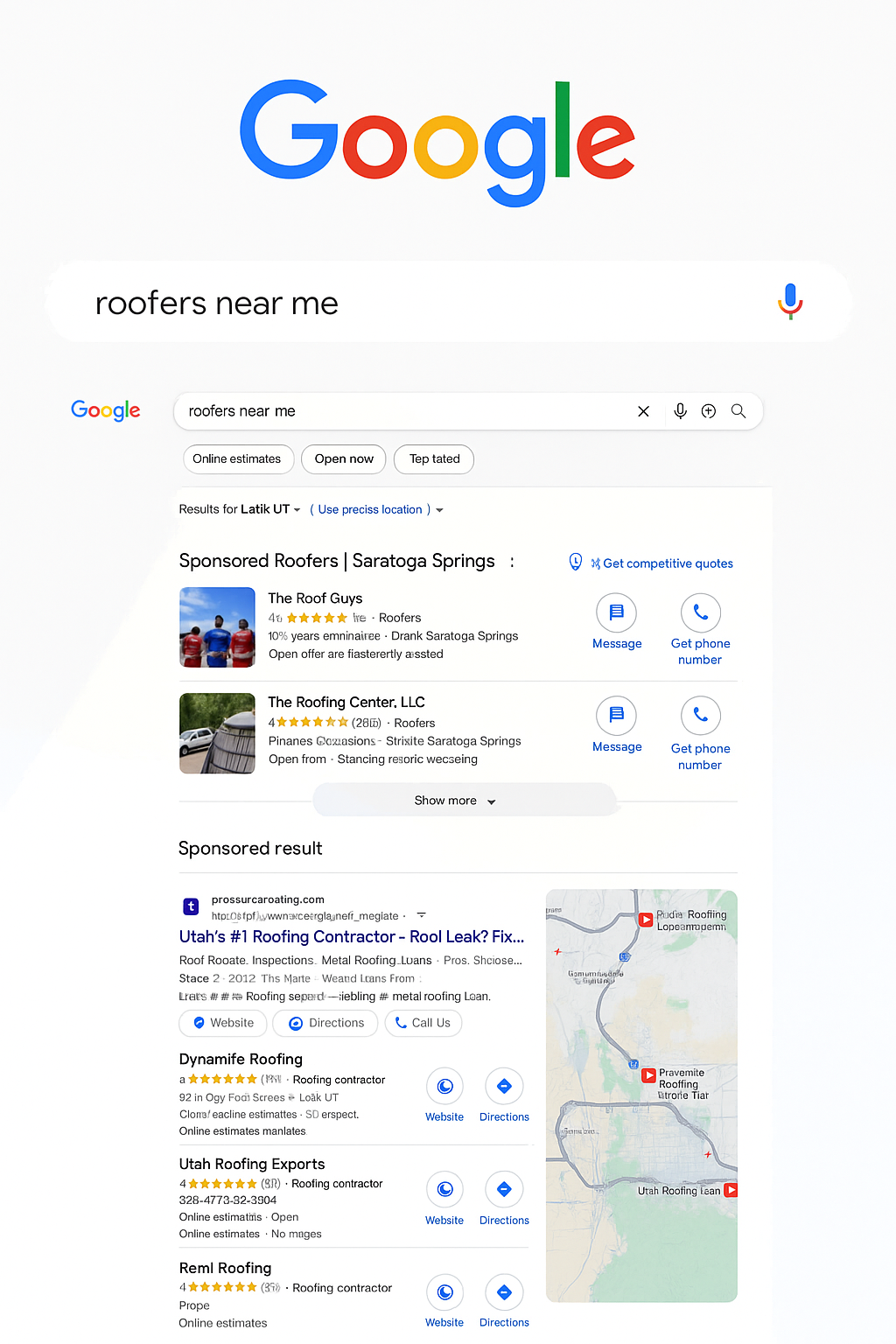If you’re a roofing contractor watching another competitor’s schedule fill up while yours has gaps, there’s a good chance they’ve figured something out: Facebook ads work when done right. Many roofers dismiss Facebook as “just for homeowners sharing photos,” but the platform’s advertising system has evolved into one of the most powerful lead generation tools available to contractors.
With over 70% of American adults using Facebook regularly, including the majority of homeowners in your service area, the platform offers unique targeting capabilities that can put your roofing business directly in front of people who need your services. But there’s a significant difference between running ads that drain your budget and implementing a strategy that delivers consistent, qualified leads.
Key Takeaways
- Lead form ads allow prospects to request quotes without leaving Facebook, increasing conversion rates by 30-40% compared to website redirects.
- Budget flexibility works for small and large contractors alike, with successful campaigns possible starting at $500-1,000 monthly in most markets.
- Creative testing is essential for success. The top-performing contractors regularly test different images, copy, and offers to improve results over time.
- Integration with your CRM system ensures leads never fall through the cracks. Quick follow-up on Facebook leads dramatically increases conversion rates.
- AI-powered Meta Advantage+ campaigns introduced in 2025 have simplified campaign setup while improving targeting for contractors with limited marketing experience.
What Exactly Are Facebook Ads and Why Should Roofers Care?
Facebook Ads Are Targeted Digital Messages That Deliver Results
Facebook ads (now technically “Meta ads” since the company rebranded) are paid promotions that appear in Facebook and Instagram feeds, stories, and other placements. Unlike traditional advertising where you pay for eyeballs regardless of who’s seeing your message, Facebook ads allow you to specify exactly who should see your ads based on demographics, interests, behaviors, and location.
For roofing contractors, this matters tremendously. Instead of paying for a billboard that everyone drives past (including children, renters, and people outside your service area), Facebook lets you show your ads specifically to homeowners within your service radius who match the profile of your ideal customer.
According to a 2025 contractor marketing study, roofers who leverage Facebook ads effectively generate leads at 40-60% lower cost than traditional marketing channels like direct mail or print advertising. The targeting precision means your budget works harder—you’re only paying to reach potential customers, not the general public.
Here’s what makes Facebook ads particularly valuable for roofing contractors:
- Hyper-local targeting: Set exact service area boundaries by zip code or mile radius
- Property targeting: Focus on homeowners, not renters
- Timing advantage: Display ads after storms or during seasons when roofing is top of mind
- Visual format: Showcase your best work with before/after photos and videos
- Lead capture: Collect prospect information directly within Facebook
A well-executed Facebook ad campaign doesn’t just generate leads—it pre-qualifies them through the targeting and messaging, making your sales process more efficient.
| Traditional Advertising | Facebook Ads |
|---|---|
| Broad audience exposure | Precise targeting of potential customers |
| Hard to track performance | Detailed analytics and conversion tracking |
| Fixed costs regardless of results | Pay only for actual impressions or leads |
| Limited creative testing | Easy A/B testing of multiple messages |
| Static messaging | Dynamic offers based on customer behavior |
When implemented correctly, Facebook advertising becomes more than just another marketing channel—it transforms into a predictable lead generation system for your roofing business.
How Do Facebook Ads Work for Contractors?
They Connect You With Homeowners Ready for Roofing Services
Facebook’s advertising system works on an auction model, where you bid to show your ads to your target audience. The system determines who sees your ads based on three key factors:
- Your bid: How much you’re willing to pay for your desired result (impressions, clicks, or leads)
- Ad quality and relevance: How well your ad resonates with your target audience
- Estimated action rates: The likelihood someone will take your desired action
For roofing contractors, the most effective approach is focusing on lead generation campaigns. These specifically designed ads include forms that capture prospect information directly within Facebook, eliminating friction in the lead collection process.
Facebook’s 2025 Meta Advantage+ system has simplified campaign setup while improving results for contractors with limited marketing experience. This AI-powered tool automatically optimizes your targeting and budget allocation based on who’s most likely to become a customer.
The process works in three core steps:
Step 1: Campaign Setup and Audience Definition
You define who should see your ads based on location, demographics, and interests.
Example targeting parameters for roofing contractors:
- Geographic area: Your service radius (typically 15-50 miles)
- Age range: 35-65 (primary homeowner demographic)
- Home ownership: “Likely homeowners”
- Property details: Home age, value range, recent purchase
- Interests: Home improvement, DIY, home ownership groups
Step 2: Creative Development and Testing
You create ad content that speaks to homeowner needs and concerns.
Effective ad elements for roofers:
- Clear value proposition (free inspections, financing options, warranty details)
- High-quality images of your work (before/after photos perform best)
- Social proof elements (reviews, testimonials, project counts)
- Urgency factors (seasonal offers, limited-time promotions)
Step 3: Lead Capture and Follow-up
When homeowners click your ad, they see a pre-filled form requesting basic contact information and details about their roofing needs.
The most successful roofing contractors connect these leads directly to their CRM and follow up within minutes—not hours or days. Quick response dramatically increases conversion rates.
| Lead Response Time | Average Conversion Rate |
|---|---|
| Under 5 minutes | 21% |
| 5-30 minutes | 14% |
| 30-60 minutes | 10% |
| 1-24 hours | 7% |
| Over 24 hours | 4% |
Source: Harvard Business Review Lead Response Study, updated benchmark data 2025
What makes this system especially powerful for contractors is that it works at any scale. Whether you want 5 leads per week or 50, the system can be adjusted to deliver a consistent flow that matches your capacity.
What Types of Facebook Ads Work Best for Roofing Contractors?
Lead Form Ads Outperform Other Formats for Home Services
While Facebook offers multiple ad formats, certain types consistently outperform others for roofing contractors. Based on aggregated data from contractor campaigns in 2023-2025, here’s how the formats rank for lead generation effectiveness:
-
Lead Form Ads: These allow prospects to submit their information without leaving Facebook. Form completion rates average 25-35% higher than landing page conversions.
-
Video Ads: Short (30-60 second) videos showcasing roof replacements, material options, or customer testimonials generate strong engagement.
-
Carousel Ads: Multiple images in a swipeable format let you showcase different services, materials, or before/after transformations.
-
Image Ads: Simple but effective, especially when showing dramatic before/after projects or weather damage imagery.
-
Stories Ads: Full-screen vertical format ads that appear in Facebook and Instagram Stories.
For most roofing contractors, lead form ads deliver the best return on investment. They eliminate friction by keeping users on the platform and pre-fill information Facebook already knows (name, email, phone), making form completion simple.
Here’s what makes an effective lead form ad for roofers:
Main Image/Video:
- High-quality photos of completed projects
- Before/after comparisons
- Your team in branded uniforms
- Brief videos of installation process or testimonials
Headline:
- Clear offer (Free Roof Inspection, Storm Damage Assessment)
- Location-specific messaging (“[City Name] Roof Replacement Specialists”)
- Problem-solution framework (“Stop Roof Leaks Before Winter Hits”)
Form Questions: Keep it simple but pre-qualify
- Name and contact information (pre-filled by Facebook)
- Address or zip code
- Project timeframe (Immediate, 1-3 months, Planning ahead)
- Type of roofing project (Repair, Replacement, Inspection)
TEMPLATE: High-Converting Roofing Ad Copy
Headline: [Offer] + [Location] + [Timeframe]
Example: "Free Roof Inspection | [City] | 48-Hour Response"
Primary Text:
Is your roof [problem situation]? Our [years in business] years of experience helps [city] homeowners [benefit].
⭐️ [Social proof point - number of projects, reviews]
✅ [Unique value proposition 1]
✅ [Unique value proposition 2]
✅ [Unique value proposition 3]
Limited availability for [seasonal timeframe]. Tap "Learn More" to schedule your [offer].
A well-structured lead form campaign typically yields leads at $35-75 each in most markets, significantly lower than traditional marketing channels like direct mail ($100-150 per lead) or canvassing ($90-120 per lead).
What separates successful Facebook advertisers from those who waste money is proper tracking and optimization. The Meta Ads Manager provides detailed metrics on which ads generate the most leads and at what cost, allowing you to continuously refine your approach.

How Much Should Contractors Budget for Facebook Ads?
Smart Budgeting Starts With Your Lead Goals
The appropriate budget for Facebook advertising depends entirely on your business goals, market, and capacity. Unlike traditional advertising with fixed costs, Facebook allows flexible spending that can scale up or down based on results.
For roofing contractors just starting with Facebook ads, here’s a practical budgeting framework:
Step 1: Determine your lead goal
Start by calculating how many jobs you want per month, then work backward.
For example:
- Target: 5 new roofing jobs monthly
- Average close rate from qualified leads: 25%
- Required leads: 20 monthly
Step 2: Estimate your cost per lead
Cost per lead varies by market and channel, but here’s what roofers typically see in 2025 (based on Peak Performance 2025 benchmarks and current ad data):
- Competitive urban markets: $150–$250 per lead
- Suburban markets: $100–$150 per lead
- Rural markets: $75–$125 per lead
Step 3: Calculate your initial budget
Multiply required leads by estimated cost per lead:
20 leads × $125 average cost = $2,500 monthly budget
This framework gives you a realistic starting point, but the real advantage of Facebook and Google advertising comes from tracking performance data and adjusting weekly.
| Monthly Ad Budget | Typical Lead Volume (Roofing) | Recommended For |
|---|---|---|
| $1,000–2,000 | 8–20 leads | Small contractors or those testing the platform |
| $2,000–4,000 | 20–40 leads | Established single-crew operations |
| $4,000–7,000 | 40–80 leads | Multi-crew operations with solid follow-up systems |
| $7,000+ | 80–200+ leads | Large operations with dedicated sales teams |
The most successful contractors follow a “test and scale” approach:
- Start with a modest budget ($1,500–2,000)
- Test multiple ad variations to find what converts
- Optimize based on cost-per-lead and close rate
- Scale up budget on your best-performing ads
Remember that spending more doesn’t automatically yield better results. A well-structured $1,000 campaign typically outperforms a poorly targeted $5,000 campaign. The key is continuous refinement based on data.
Another critical consideration is seasonal adjustment. Many roofers increase budgets during spring and fall (peak seasons) and scale back during winter months, though winter campaigns often yield lower cost per lead due to reduced competition.
As you refine your campaigns, you’ll identify your true customer acquisition cost, allowing for more precise budgeting. Many established roofing contractors leverage Facebook ads as their primary lead source because they’ve confirmed the economics work predictably.
How Can Contractors Create Effective Facebook Ad Campaigns?
Success Comes From Strategy, Not Just Budget
Creating effective Facebook ad campaigns requires more than just throwing money at the platform. The most successful contractors follow a structured approach that combines targeting precision with compelling creative and efficient lead management.
Here’s a step-by-step process for building campaigns that deliver results:
1) Set Up Your Business Foundation
Before creating your first ad:
- Create a complete Business Manager account
- Install the Meta Pixel on your website for tracking
- Set up conversion tracking for lead forms and thank you pages
- Connect your CRM for lead synchronization (when possible)
2) Define Your Ideal Customer Profile
The power of Facebook advertising is targeting precision. Define your ideal customer based on:
- Geographic boundaries (service area)
- Demographics (age, income bracket, homeownership)
- Behavioral factors (recent movers, home improvement interests)
- Lookalike audiences based on past customers
In 2025, Meta expanded its targeting options for contractors, allowing you to filter by home age and value—especially valuable for roofers since older homes more frequently need roof replacement.
3) Create Compelling Ad Creative
What separates high-performing ads from budget-wasters is the creative approach. The most effective roofing ads include:
- Professional photos of your actual work (not stock images)
- Concise copy focused on customer problems and solutions
- Clear calls-to-action that match customer needs
- Social proof elements (reviews, project counts)
- Your service area in the headline or text
4) Set Up Proper Tracking and Measurement
The true advantage of digital advertising is accountability. Implement:
- Website conversion tracking
- Phone call tracking
- Form submission recording
- Lead-to-sale attribution
5) Build a Rapid Response System
Facebook leads convert at 2-3× higher rates when contacted within 5 minutes versus 30+ minutes. Implement:
- Automated lead notifications to your team
- CRM integration for lead management
- Text/email autoresponders for after-hours submissions
- Scheduled follow-up sequences for leads that don’t immediately convert
Template: Facebook Ad Testing Matrix
For each campaign, create variations to test different elements:
| Test Element | Variation A | Variation B | Variation C |
|---|---|---|---|
| Main Image | Completed roof | Before/After | Team photo |
| Headline | “Free Inspection” | “Storm Damage?” | “50-Year Warranty” |
| Primary Text | Problem-focused | Solution-focused | Testimonial-focused |
| Call to Action | “Get Free Quote” | “Schedule Inspection” | “See if You Qualify” |
According to BuilderFunnel research, contractors who test at least 3 creative variations per campaign see a 35% lower cost per lead than those who run single-version campaigns.
One of the most effective recent developments is Meta’s AI-powered creative testing. This new functionality automatically tests multiple versions of your ad and allocates more budget to the best performers, taking the guesswork out of optimization.
A common mistake among roofing contractors is creating campaigns focused on “brand awareness” rather than direct lead generation. While building your brand matters, measurable lead generation campaigns deliver immediate ROI that can be tracked and refined.
6) Implement a Consistent Testing Schedule
Successful advertising isn’t “set it and forget it.” Establish a regular cadence:
- Weekly: Review basic performance metrics
- Bi-weekly: Adjust budget allocation to top performers
- Monthly: Test new creative approaches
- Quarterly: Revisit targeting and overall strategy
According to marketing research by IT Vibes, contractors who follow this type of structured optimization approach see their cost per lead decrease by an average of 18% every quarter during their first year of Facebook advertising.
By following this systematic approach to Facebook advertising, you create a repeatable, scalable lead generation system rather than a random marketing expense.

How Can Roofers Optimize Facebook Ads for Maximum ROI?
Performance Optimization Is Where Profits Are Made
The difference between roofing contractors who see Facebook ads as a cost center and those who view them as a profit center often comes down to optimization. Here’s how the top-performing contractors continuously improve their campaigns:
1) Implement Conversion Tracking Properly
You can’t improve what you don’t measure. Proper tracking includes:
- Meta Pixel installation on your website
- Conversion events for key actions (form submissions, phone calls)
- Value tracking for different lead types
- CRM integration to track leads through the sales process
Many roofing contractors stop at counting leads, but the true measure of success is cost per acquired customer. By tracking leads through to completed jobs, you can identify which ad variations not only generate inquiries but result in paying customers.
2) Leverage Custom and Lookalike Audiences
The most powerful targeting feature on Facebook is custom audience creation:
- Customer List Audiences: Upload your past customer data to find similar prospects
- Website Visitor Audiences: Target people who visited your website but didn’t convert
- Engagement Audiences: Reach people who engaged with your Facebook page or ads
- Lookalike Audiences: Find new prospects who match your best customers’ profiles
According to LeadsBridge data, roofing contractors using lookalike audiences based on past customers see 40-60% higher conversion rates compared to interest-based targeting alone.
3) Test Multiple Ad Variations Systematically
The highest-performing contractors consistently test:
- Different visual approaches (projects, teams, before/after)
- Various offers (free inspections, seasonal discounts, financing options)
- Multiple headline formulations
- Different lead form questions to improve lead quality
Meta’s 2025 AI Advantage+ system now automates much of this testing, but understanding what works and why remains critical for continued improvement.
4) Optimize for Lead Quality, Not Just Quantity
A common mistake is optimizing solely for cost per lead without considering lead quality. Better approaches include:
- Adding qualification questions to lead forms
- Creating separate campaigns for different service types
- Using higher-intent call-to-actions that attract serious buyers
- Adjusting targeting to exclude unlikely prospects
One effective strategy is implementing a “lead scoring” system in your CRM, then feeding this data back into your Facebook campaign optimization.
TEMPLATE: Lead Quality Scoring System
Score each lead on a 1-5 scale based on these factors:
1. Project Timeline
5 = Immediate need (< 30 days)
3 = Near-term plan (1-3 months)
1 = Future planning (3+ months)
2. Decision-Making Authority
5 = Homeowner, ready to decide
3 = Homeowner, needs co-decision maker
1 = Gathering information for someone else
3. Budget Alignment
5 = Budget matches service costs
3 = Some budget flexibility needed
1 = Significant gap between budget and costs
4. Property Qualification
5 = Property is ideal for your services
3 = Property needs assessment
1 = Property likely not suitable
Total scores:
16-20: A-Lead (high priority)
11-15: B-Lead (medium priority)
<10: C-Lead (low priority)
By tracking which ad variations produce more A and B leads, you can optimize for quality rather than just volume.
5) Refine Targeting Based on Performance Data
After running campaigns for 30+ days, examine your results to identify:
- Best-performing demographics (age ranges, locations)
- Most profitable times of day and days of week
- Highest-converting ad placements (feed, stories, right column)
- Most valuable interest categories
Use this data to refine your targeting and exclude underperforming segments.
6) Implement Seasonal and Weather-Based Strategies
Roofing demand fluctuates with seasons and weather events. Optimize accordingly:
- Increase budgets after storms or severe weather
- Adjust messaging seasonally (spring maintenance, fall winterization)
- Create specific campaigns for weather-related needs
- Use Meta’s weather-based triggers to activate campaigns automatically
For a comprehensive approach to using these seasonal strategies, check out this guide on how to market a roofing company at different growth stages.
7) Focus on Your Follow-Up System
The highest ROI optimization happens after the lead comes in:
- Implement instant notifications to sales teams
- Create automated but personalized initial responses
- Develop a structured follow-up sequence (call, text, email)
- Track contact attempts and conversion rates by ad source
According to industry data, roofing contractors who contact Facebook leads within 5 minutes see conversion rates 3-4× higher than those who wait an hour or more.
By implementing these optimization strategies, your Facebook advertising transforms from a marketing expense into a predictable lead generation system with measurable ROI.
Closing Thoughts: Making Facebook Ads Work for Your Roofing Business
Facebook advertising isn’t just another marketing channel for roofing contractors—it’s a precision targeting system that connects you directly with homeowners who need your services. When implemented correctly, it delivers measurable results that can scale with your business growth.
The platform’s ability to target homeowners based on location, property characteristics, and life events makes it uniquely powerful for roofing lead generation. And with the 2025 updates to Meta’s AI-driven campaign optimization, even contractors with limited marketing experience can achieve impressive results.
The most successful contractors approach Facebook advertising systematically—testing different messages, tracking results meticulously, and continuously refining their approach based on data. This scientific approach turns advertising from guesswork into a predictable system.
As you prepare for the coming spring season, now is the perfect time to refine your Facebook advertising strategy. Whether you’re just getting started or looking to improve existing campaigns, focus on creating compelling offers, targeting the right homeowners, and implementing rapid follow-up systems.
Ready to transform your approach to roofing lead generation? Schedule a discovery call with our team to develop a customized Facebook advertising strategy for your specific market and business goals.
Frequently Asked Questions About Facebook Ads for Contractors
How quickly will I see results from Facebook ads for my roofing business?
Most roofing contractors see initial leads within the first 24-72 hours of campaign launch. However, the optimization period typically takes 2-3 weeks as Facebook’s algorithm learns which users are most likely to convert. For maximum effectiveness, plan a 90-day initial commitment to allow for proper testing and refinement. The contractors who see the best results are those who commit to ongoing improvement rather than expecting instant perfection.
How much should I budget for Facebook ads as a roofing contractor?
Start with a minimum budget of $500-1,000 monthly for a single market to ensure sufficient data for optimization. Most established roofing contractors invest $1,500-3,000 monthly in Facebook advertising with an expected cost per lead of $35-75 depending on market competition. This typically generates 20-60 qualified leads monthly. Rather than focusing solely on budget, track your customer acquisition cost and return on ad spend to determine the optimal investment level for your business.
What’s the difference between boosting posts and running actual Facebook ads?
Boosting posts is a simplified way to promote your organic content to more people, but it offers very limited targeting and optimization capabilities. Professional Facebook ad campaigns through Ads Manager provide superior targeting options, detailed performance data, and lead generation tools specifically designed for contractors. While boosting posts occasionally has value for building awareness, dedicated lead generation campaigns typically deliver 3-5× better results for the same budget.
Should I hire someone to manage my Facebook ads or do it myself?
While DIY management is possible using Meta’s simplified tools, most successful roofing contractors either hire a dedicated marketing person or partner with an agency that specializes in contractor advertising. The platform’s complexity, combined with the need for consistent testing and optimization, typically makes professional management more cost-effective. If your monthly ad budget exceeds $1,500, professional management usually pays for itself through improved performance. For smaller budgets, Meta’s AI-powered Advantage+ campaigns provide a reasonable alternative for DIY marketers.
How can I make sure my Facebook leads turn into actual roofing customers?
The conversion of Facebook leads to customers depends more on your follow-up process than on the ads themselves. Implement a rapid response system where leads are contacted within 5 minutes, use a CRM to track all communication, create a structured follow-up sequence (minimum 6-8 touches), and train your team on handling leads from digital channels. Facebook leads often require more nurturing than direct referrals, but they convert at similar rates when followed up properly. For more strategies on turning leads into sales, check out this guide on unconventional marketing strategies for roofers.
How do the new 2025 Meta Advantage+ campaigns benefit roofing contractors?
The new AI-powered Advantage+ campaigns simplify the advertising process while improving results through automatic optimization. Benefits include: automated creative testing across multiple variations, intelligent budget allocation to top-performing audiences, simplified campaign setup requiring less technical knowledge, and improved targeting using Meta’s vast data resources. For roofing contractors with limited marketing expertise, these tools have reduced the learning curve while improving typical campaign performance by 15-25% compared to manually optimized campaigns.
Table of Contents
Keep on learnin'
Related Articles

What Are Google Ads and How Do They Work for Roofing Companies?

Year-End Tax Savings for Roofers: Why Paying for Marketing Up Front Pays Off

The Top 5 Marketing Mistakes Roofing Companies Make (And How to Fix Them)

